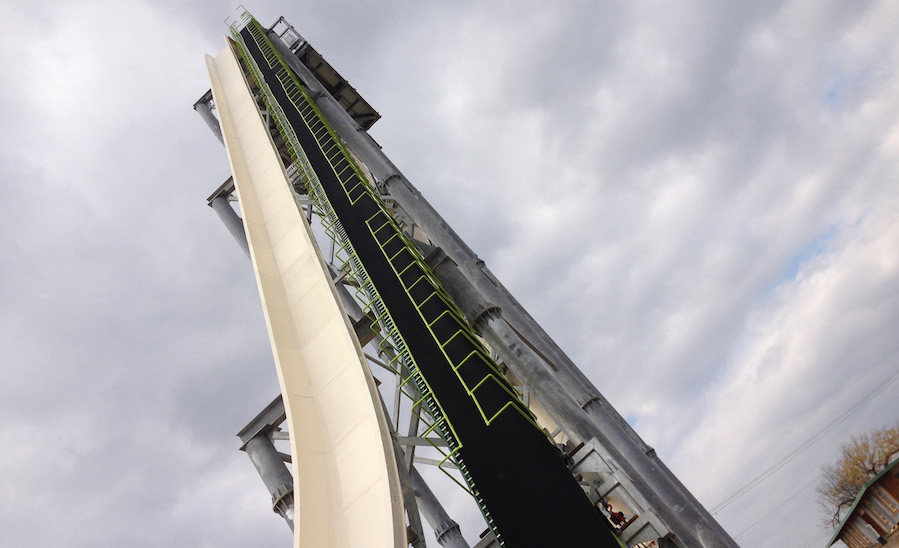Some of the fun may have gone out of the idea of being an amusement park engineer following the death Aug. 7th of a Kansas boy on a 168-foot waterslide.
The tragedy has cast an unwanted spotlight on everyone from the local officials who approved the Verrückt, German for “insane,” and the world’s tallest waterslide, to the designer of the ride itself to an engineering firm that worked on the ride structure but wasn't the ride's designer.
Kansas City Police are investigating the fatal accident at the Schlitterbahn Kansas City Waterpark, where two woman were also reportedly injuried.
Lawyers hired by the family of the boy and the injured women are also conducting their own investigations and trying to get to the bottom of what caused the accident, in which the boy was decapitated while hurtling along the waterslide.
ENR Correspondent Scott Van Voorhis checked some of the details about what happened and the origins of the ride, which is now closed for the season.
Riders had been strapped into three person rafts and sent down a “jaw dropping” 168 foot tower/waterslide, “only to be blasted back up a second massive hill and then sent down yet another gut wrenching 50 foot drop,” according to a description on the waterpark’s website.
That initial drop, at 17 stories, is “taller than Niagara Falls and the Statue of Liberty (from toe to torch),” according Schlitterbahn’s website.
First launched in 2014 and marketed to “adventure seekers,” the ride became so popular that reservations were required.
The Kansas City Star took an in-depth look at the ride and its design and potential flaws. “Riders are harnessed in with two nylon seatbelt-like straps — one that crosses the rider's lap, the other stretching diagonally like a car shoulder seatbelt,” according to the paper’s account. “Each strap is held in place by long Velcro-style straps, not by buckles. Riders also hang on to ropes inside the raft.”
Park employees were in charge of loading the rafts and ensuring that three riders had a total weight of 400 to 550 pounds.
The waterslide was enclosed by nylon netting supported by metal poles.
So what went wrong?
“Physics and engineering experts” interviewed by the Star have questioned the way the boy and the two women were loaded into the raft, with the boy in front. Putting the majority of the weight in the back of the raft on a “high velocity ride” where rafts are hurtled forward at speeds of up to 70 mph could put the raft at risk of tipping upward or going airborne.
Experts cited by the paper have also questioned whether the safety straps – which are held in place not by buckles, as in a roller coaster, but by Velcro-style straps, were sturdy enough. And questions have also been raised about the netting, which could take off a limb if a rider somehow got caught up in it, Mark Hanlon, a licensed mechanical engineer who was a certified inspector of amusement attractions in California, told the Star.
However, exactly who was in charge of ensuring the safety of the ride is unclear.
The Kansas Dept. of Labor never inspected it, with the main permits issued by the local municipal government, the Star has reported. Instead, the labor department’s role was limited to auditing the paperwork at the park to check and see if Schlitterbahn had paid for yearly inspections by technicians, either outside consultants or employees, the paper reports.
The engineering firm on the project, BSE Structural Engineers, worked on the Verrückt.
Steven Busey, one of the firm’s principals, states in his profile on BSE’s website that he has developed “a client base in the building, aquatic, amusement and water slide markets.” Kevin Boehringer, another principal at the firm, cites extensive design experience in a wide range of buildings and structures, including “amusement rides and attractions.”
Boehringer, in an email responding to questions from ENR, offered condolences to the family of the boy who was killed. “Our prayers are with them.” But he said his firm did not play a role in designing the ride itself.
“As for our role on the Verruckt project, it was to provide structural engineering services for the ride structures,” Boehringer said.
So who designed the ride, including its critical mechanical systems?
The Verruckt was the brain child of Jeff Henry, co-owner of the Schlitterbahn waterpark empire, and John Schooley, the company’s head designer, according to the Star, citing a bevy of interviews granted to various media outlets over the years by Henry.
No slouches, Henry and Schooley, have teamed up on eight patents related to waterpark rides, the Star has reported.
“Henry holds numerous patents for ride innovations and has brought inland water surfing, uphill water coasters and endless tube rides to the industry,” Schlitterbahn notes on its website.” The Henry family operates four Schlitterbahn parks around the country.”
But neither one is a licensed engineer, according to the paper, which reported that Schlitterbahn employee Mark Stuart was listed on the building permit as the project’s architect.
Henry and Schooley designed the ride using trial and error. Sandbags fell off the ride in earlier versions, prompting a series of changes to the angles of the ride, according to the paper.
A Schlitterbahn spokeswoman declined to answer whether any other certified engineers, beyond BSE, were involved in the “vetting, review or design of the ride,” and, if they weren’t, then why?
The company has expressed its condolences and offered grief counselors to employees and customers of the park who may have been affected by events.
“We do so appreciate you reaching out to Schlitterbahn for additional facts related to your story. At this time, we are not commenting beyond our issued statements,” the company said in an email.


Post a comment to this article
Report Abusive Comment